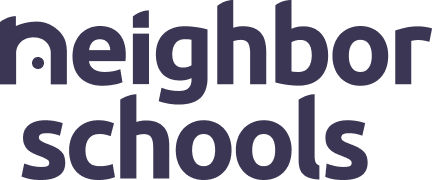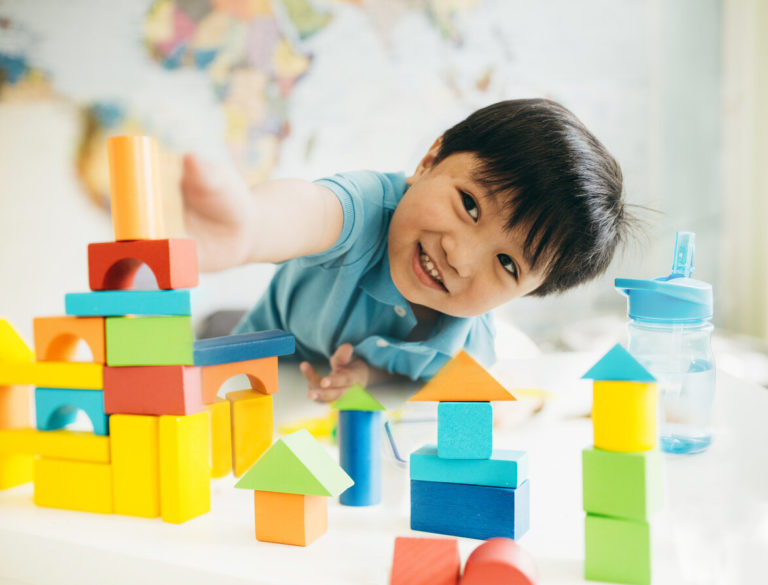What do an applesauce cup, an empty coffee can, and a cardboard box have in common? They’re “trash” that can easily become toys that will engage your toddler’s imagination and develop motor skills – for free!

Toddlers are excited to learn about the world around them. They devote lots of time and effort to sorting objects into categories, figuring out how things open and close, and pretending to have different grown-up jobs. Before you spend hundreds of dollars on educational toys, take a look at what you already have at home. Imaginative play does not have to be expensive.
Here are the top five items to rescue from recycling and put in the playroom:
Clear plastic (styrene) clamshell boxes. Many berries and small tomatoes are packaged in clear boxes or tubs with pierced sides, usually with a snap-down hinged lid. These make wonderful strainers or sifters for sensory tables stocked with water or sand. To prep: Carefully cut along the fold line that divides the lid from the base, or remove all film from the top, sealing edge of the food package. Check for sharp edges. Enjoy!
Junk mail postcards. Save the nice, thick, glossy ones. Older toddlers can practice cutting using safety scissors on the cards – they’re just the right size for little hands, and the extra weight of the card means less frustration at the paper crumpling. Younger children will enjoy using the cards to pretend to be the Post Office carrier. They will enjoy distributing and collecting the “mail” from their playmates, or their stuffed animals. You can even make a pretend mailbox (see below), and store the mail inside of it.
Boxes. Before you deconstruct and flatten your home delivery boxes for the recycling bin, take a look at sizes and shapes, and think how these packaging items could be reused.
Make a mail box! Cut a slot in one side of a square box (the kind that bike helmets are shipped in, or Hello Fresh). A shoe box also works (cut slot in the lid). Children love poking the mail through the slot, then opening the box to retrieve the mail.
Mailing tubes make wonderful tunnels for little toy cars.
Make a castle or fort from those big delivery boxes. Cut along one side to “open up” the box. Cut off the top and bottom “wings” so that you have a long sturdy piece of cardboard, corners already made. Now you have a pre-folded screen to partition off a little space for imaginative play, that is about waist height for your children.
You can attach one or more similar boxes to create a bigger play space. Maybe cut small windows into one panel! Bonus: let children color their castle themselves, with non-toxic crayons. Who says you can’t draw on the walls?
Single serve applesauce and yogurt containers (Tip: select containers that have a base smaller than the top.) Children ages 2 and up enjoy stacking cups into towers, sorting the cups by color, or using the cups as nests for small plush animals. Older children will enjoy making more elaborate pyramids or castles, stacking multiple layers of cups. Bonus: The cups also work well at the sensory table. Teachers can use the cups for mixing powdered tempera paints, dishing out snacks, or sorting all kinds of small toys (crayons, stickers) for distribution.
Coffee cans with snap-on plastic lids make wonderful storage containers for sets of small similar toys, like little cars, dolls, or finger puppets. Toddlerss love to open and close the containers, and discover the treasures inside. A package of multi-colored pompoms (one dollar at a craft store) stored inside a can is a special treat for small children who enjoy fluffy textures. They will drop the pompoms and pick them up, over and over.
Next time you sort your trash, try to look at it with a little one’s eyes. You’ll find a lot of treasure.
About NeighborSchools
Our mission is to help experienced educators launch and operate Home Daycares. In doing so, we aim to increase access to affordable, high-quality child care for parents everywhere. Children get amazing early childhood education programs, parents get a trusted partner, and providers can earn a livable wage doing what they love. It’s a win-win-win.
Want to learn more? Find a home daycare near you or contact us.



